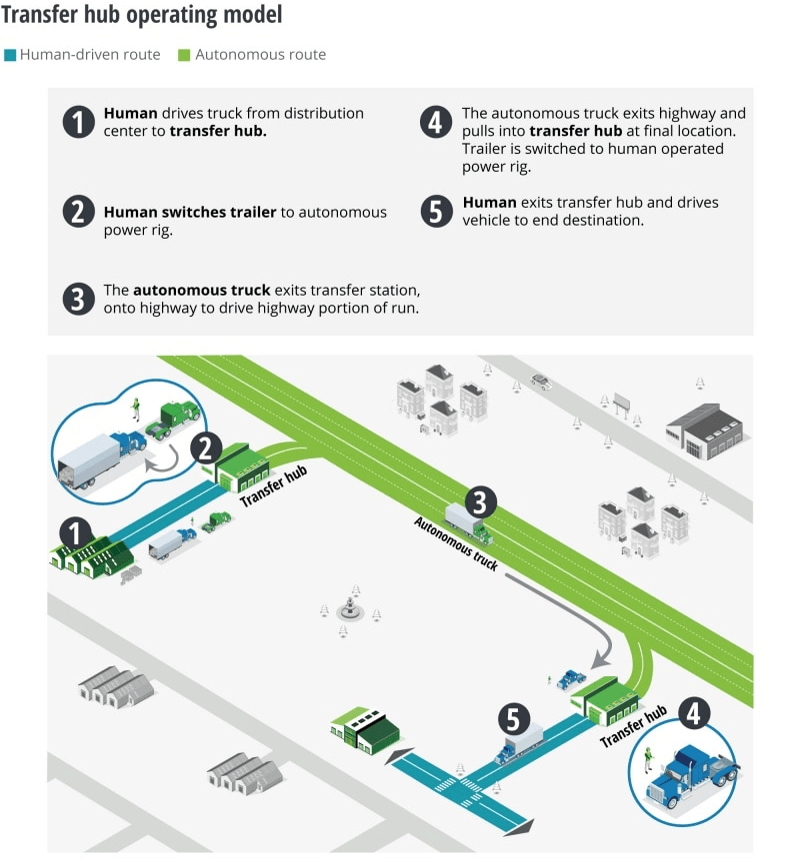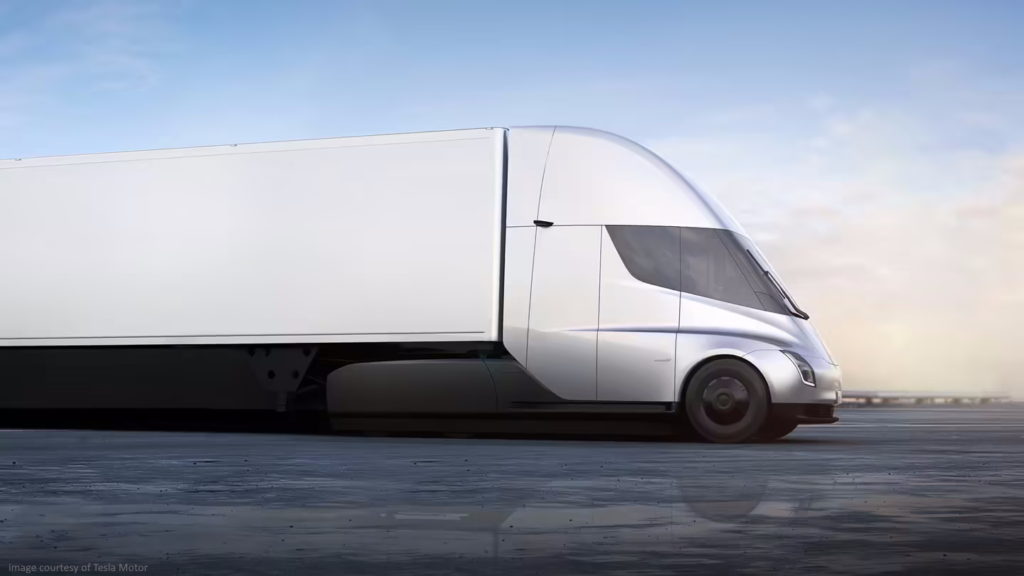As technology advances and the cost of Supply Chain skyrockets one of the costs cutting avenues becoming more available is the autonomous truck. This article by Michael McGrath Goes in depth on the advantages and structure of autonomous trucks in the trucking hub environment.
How Autonomous Long-Haul Trucking Is Being Implemented
Although work on autonomous driving for long-haul trucks has been in development for years, it is only now becoming clear how this technology will be implemented. It will be hugely different from the way trucking works today.
Autonomous Long-haul Trucking Will Use Transfer Hubs
It has become clear that autonomous long-haul trucking will initially use a transfer hub model. A driver will drive the truck from a warehouse or factory to a transfer hub near an on-ramp for the major highway route. The trailer will be swapped over to attach to an autonomous truck at the transfer hub. The autonomous truck will then drive the long route to a transfer hub nearest its destination, typically hundreds or thousands of miles. There, the reverse process will occur with a driver taking the trailer to its last location, such as a distribution center. A variation of this process is where the trailer stays attached to the autonomous truck, but a driver gets into the cab for the local portion. Refueling along the route can also be done at transfer hubs.
The following chart from Deloitte Insights illustrates the transfer hub concept. It shows the human driver route in blue and the autonomous truck route in green, although the autonomous truck route would typically be more than 1,000 miles and more than 20 hours of driving, and the human driver route would typically be less than an hour and under 50 miles.

The transfer hub model greatly simplifies that task for autonomous trucking by focusing only on highway driving. Autonomous highway driving is a much simpler process and involves significantly less mapping, but it provides almost all of the benefits we will discuss shortly. This simplification enables the technology to be brought to market much earlier.
The Benefits of Autonomous Long-Haul Trucking
The significant benefits of autonomous long-haul trucking combined with the more straightforward implementation of the transfer hub model make it an early opportunity. The benefits are so substantial that traditional driver-based long-haul trucking won’t be competitive with autonomous trucking in the long term.
The first five benefits directly reduce shipping costs. The final two benefits accrue to others and society in general. These are important, but as we have seen with vaccinations, benefits to others or society don’t always motivate action.
1. Significant Cost Reduction by eliminating driver
Autonomous trucking will eliminate the highest cost by removing the need for truck drivers. Labor costs are approximately 42%-47% of the total cost per mile for long-haul trucking. This cost typically equates to roughly $0.94 per mile on about $1.98 per mile revenue. The operating profit is only about $0.16 per mile to put this savings into perspective.
2. Solving Driver Shortage
Solving the driver shortage problem is an associated benefit to eliminating the need for truck drivers in autonomous long-haul trucking. There is currently a shortage of almost 100,00 truck drivers in the US. Long-haul truck driving is a difficult, tedious, and inconvenient job that is hard to fill. Long-haul truckers need to be away from home for many days, sleep in their cabs, and spend long days staring at the highway. Many truckers are older and expected to retire in the next decade. Some experts estimate the need for an additional 100,000 drivers per year to fill all the trucking needs.
3. Increased Truck Utilization
Expensive long-haul trucks sit idle as drivers need to rest and take legally mandated breaks. Once a driver has driven for 11 hours, they must take a 10-hour break. So, for example, a 1,600-mile route at an average of 65 miles per hour would take 25 hours of driving. A driver would need to take two 10-hour breaks, although there is an incentive to stretch it a little and reduce driving time to 22 hours and avoid one of those breaks.
Autonomous trucks won’t need to take a rest break after 11 hours. They can just keep driving, which will dramatically increase truck utilization. Here is an example. In test runs with Kodiak Robotics, US Express operated four round trips from Dallas to Atlanta for 6,350 miles, delivering commercial loads 24 hours a day for 131 total hours.
US Express disclosed that it averages 1,655 miles per tractor per week and $3,861 in revenue. The test runs described covered 6,350 miles in less than a week, which is almost four times higher. Even at a three times increase in utilization, revenue per truck would be more than $11,000, and only a third of the number of trucks would be needed to carry the same loads.
4. Faster Shipping Times
There will also be faster shipping times by eliminating these mandated rest times from trip time. Here is a test run example. TuSimple trucks picked up a load of fresh watermelons in Nogales, Arizona, and transported the produce across four states to a distribution center in Oklahoma City. The pick-up and delivery of the produce were done manually with a human driver, while the longest portion of the journey from Tucson, Arizona, to Dallas, Texas, was done autonomously using TuSimple’s autonomous-driving technology. The autonomous leg of the journey covered more than 900 miles. A human driver can complete the entire trip in 24 hours, including the mandatory break, while TuSimple demonstrated its autonomous system could make this trip in 14 hours, 42% faster. Faster shipping times will significantly improve supply chains because goods will be able to move much quicker through the supply chain than they do today.
5. Increase Fuel Efficiency
Autonomous long-haul trucks are more fuel-efficient. They follow driving practices that are optimized for fuel efficiency. Trials run by several companies demonstrate fuel savings of approximately 10%. This is such a significant benefit that some trucking companies are already using autonomous driving technology even with a driver present to improve fuel efficiency. With increasing fuel costs, this benefit gets even more critical.
6. Decreased Accidents
There are more than 3,000 fatal accidents annually and more than 75,000 accidents with significant injuries involving large trucks. Truck accidents are likely to be more tragic than a collision between two passenger cars because of the increased mass of the truck.
The primary causes of these accidents are:
- Driver fatigue
- Distracted driving
- Alcohol and drugs
- Speeding and overtaking
Reducing truck accidents will benefit society, but it is impossible to speculate on whose life would be saved. There may be savings in insurance and accident management for autonomous trucking companies. While this may be the most important benefit, it may not be as significant motivation as some of the other benefits.
7. Improved Highway Driving
Having just spent four days driving 2,000 miles on highways, I had a chance to observe the way long-haul trucks affect driving patterns. Some truck drivers seem intent on completing their trips as fast as possible. Many drive above the speed limit, pass other trucks just to get a little ahead, and sometimes even drive in parallel with other trucks blocking all lanes for an extended time.
It made me realize how much better it would be to drive passenger cars on the highway with autonomous trucks driving primarily at the speed limit and staying on the inside or the middle lane. They would be spaced out a safe distance from the truck ahead and provide sufficient gaps for passenger cars to enter or exit the roadway. It would almost look like a “highway train.” There would be a minimal delay in transport time, and there would not be a need to get to a specific location before driving time limits are reached.
Click here to view the original web page at seekingalpha.com










